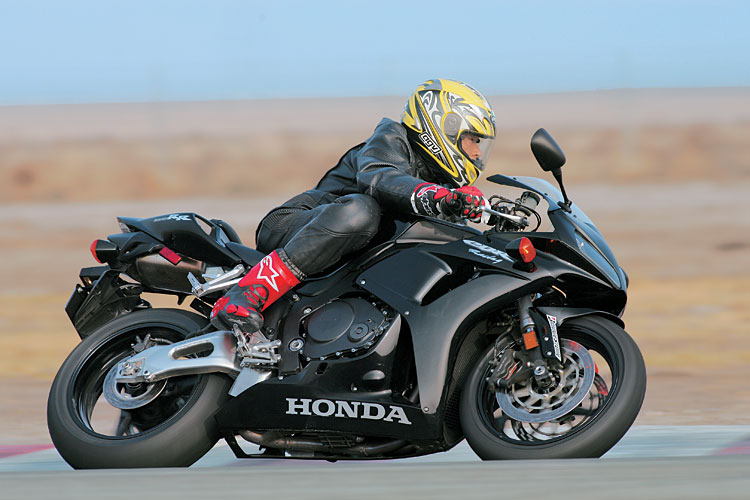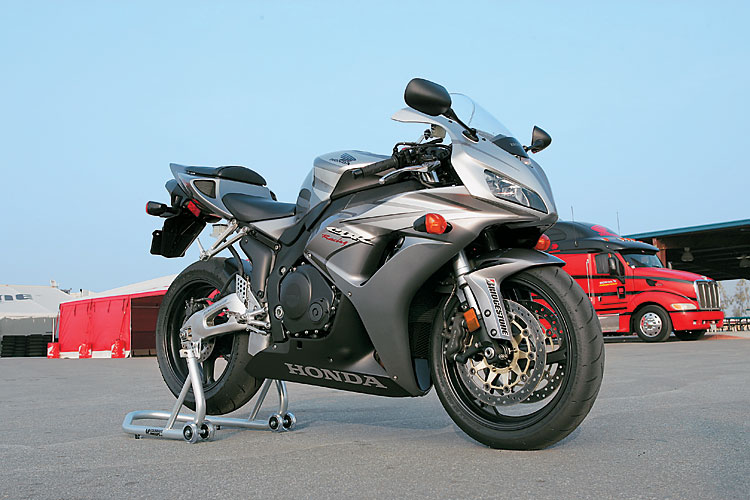Honda CBR1000RR

Old habits die hard. I ride maybe 25,000 miles a year on roads that range from interstate to gravel, and I reckon I usually hold my own. But the racetrack is different. It takes me a whole day at California's Buttonwillow circuit to overcome my road-bound inhibitions: No unexpected gravel will be strewn across the corners; no loitering idiot in an LTD is lurking over that blind rise; and no trees or concrete berms will jump out from the bends. It ought to be biker heaven. And, of course, it is - especially on the remarkable 2006 Honda CBR1000RR.
The cutting edge
First, a little background. Honda's open-class RR line dates back to the CBR900RR Fireblade of 1992, which, with 124hp and at a shade over 400lbs, effectively wrote the credo for this class: power is good, weight is bad. It was two years before the ZX9R Ninja arrived with similar power and weight. Then, in the time-honored practice of adding capacity for more power, Honda upped the ante to 918cc in 1996 with 130hp, then to 929cc in 2000 (after the arrival of Yamaha's R1), while weight dropped to around 375lbs. Displacement was bumped again in 2002 to 954cc before the full 1000cc bike arrived in 2004. As Honda generally reserves makeovers for alternate years, the 2006 iteration is effectively the first update for the CBR1000RR.
The battle for sales between the Big Four in this prestigious marketplace is fought in fractions of an ounce of weight, marginal horsepower figures and split seconds on the track. Potential sportbike purchasers will scan the spec charts for dyno readings, standing quarter times and maximum speeds, as much for post-purchase bragging rights as any intention (or ability) to use the full performance of these amazing machines. For around 11 big notes, you can ride away on a machine that will humiliate anything but a McLaren F1 on the street and, with a weekend's prep, mix it with the privateers on a racetrack. All with bulletproof reliability - and electric start.
Generalizations are dangerous, but each manufacturer's design philosophy does seem to be manifest in their machines. Kawasakis tend to be the edgiest, closest to race bikes in road manners; Suzukis light and quick handling; Yamahas brutally powerful; and Hondas perhaps the "softest" although they've surprised many testers with quicker track times in spite of being edged out in the numbers game. Not surprising then that Honda would borrow from its "winningest" Moto GP bike (62 percent of all MotoGP victories since 2002), the RC211V, two of its core technologies: mass centralization, and the Unit Pro-Link rear suspension.

Honda's goals for the 2006 CBR1000RR will be familiar to sportbike followers: reduce weight, increase performance, sharpen handling (and styling) and increase braking power. In the engine department, this required revised porting, increased compression (from 11.9 to 12.2), and a new intake camshaft with both an extra 0.2mm lift and double valve springs. These changes increase claimed horsepower by three percent. Camshafts have thinner walls and the crankshaft is lighter for quicker engine spool up, and to shed weight; the cam chain tensioner, coolant impellor, ECU and shift drum shaft are all lighter too. Magnesium replaces aluminum in the ACG cover, the exhaust is lighter, brakes discs shrink in thickness from 5mm to 4.5mm. Overall weight savings are 9lbs.
Sharper handling comes from shortened rake (by one-third of a degree) and trail (by 2mm) and a 4mm shorter swingarm, together slicing a third of an inch off the wheelbase. Bigger 320mm discs (vs. 310mm) increase anchorage.
Track time
Buttonwillow is a hop, skip and 45-minute ride west of Bakersfield at the southern end of California's San Joaquin Valley, and the site Honda chose for the '06 Blade press launch. Why introduce a road bike at a racetrack? Because, as every squid worth his (or her) salt will confirm, race-bred equals street-cred. No doubt Honda also expects to enhance its standings in World and AMA Superbike with the improved CBR as the platform. And as Honda's Jon Seidel explains, a typical CBR1000RR customer owns more than one bike, meaning there's room in the garage for a track-day tool alongside the daily driver.
Not only has Honda arranged for both the '05 and '06 bikes to be available for side-to-side comparos, but the boys from Bridgestone have brought new race rubber for us to try. The '06 CBR1000RR will come from the factory with Bridgestone's new BT015 (which will ultimately replace the BT014) with new groove patterns to expand the front tire contact patch and increase power handling at the rear. But we'll also get to try Bridgestone's BT002 PRO race tires.
Former world endurance champ Doug Toland and AMA Superbike #35 Jeff Tigert (also the Buttonwillow lap record holder - on a CBR1000RR) show us round the track, and then we're on our own. I do a half-dozen laps on the '06, then take the '05 out for comparison. It's immediately apparent that the changes Honda has made result in a quicker handling more responsive bike. I'm ordinarily skeptical of the radical claims made for apparently minor engine changes, but the '06 definitely spins up faster with a more aggressive growl from the exhaust and it pulls harder than the '05 (a rear sprocket change from 41- to 42-tooth probably helps). It's edgier than the '05, too, turning in more easily, while the brakes seemed to inspire more confidence.

Talking of confidence, Honda's speed- and acceleration-sensitive HESD electronic steering damper works flawlessly: both the '05 and '06 feel supremely stable at speed, yet slow-speed handling is unimpaired. Given the sometimes quite bumpy Buttonwillow surface, the '06 suspension works well, too, allowing the tires to follow the surface imperfections without pattering or breaking away unexpectedly. Honda has put considerable development into its HMAS multi-action front fork and Unit Pro-Link rear suspension, which contains the shock within the swingarm, reducing suspension energy transfer to the frame.
All of this translates into a machine that allows a relative track novice like me to enjoy pushing personal boundaries while knowing that the machine won't react unpredictably. I find it astonishing that such ferocious performance can be contained within a machine that is at the same time docile and easily controlled.
The sharper blade comes with a penalty, of course. The '05 bike seems more relaxed unless being pushed, and perhaps a little easier to ride, requiring less pilot input. Ergonomically, the bikes are identical: anyone over 25 won't want to spend more than a couple of hours on either machine at a time, and no one surely would be cruel enough to ask a passenger to do likewise. The pillion "seat" owes more to a birthing stool than a La-Z-Boy.
Honda motorcycles have sometimes been criticized for conservative styling: no question that the '06 Blade is much sharper in this department than its predecessor, with a slimmer front-on profile, sleek nose and cutaways in the fairing revealing black anodized casings. Very snappy.
Bridgestone Tire provided an afternoon treat, fitting their new BT002 PRO tires to the Blade's 3.5" (front) and 6.0" (rear) by 17" lightweight aluminum wheels, then softening them up with tire heaters. I've never ridden on race rubber before, and I was amazed at how different they felt, even at my relatively pedestrian speeds. Without the heavy sidewall construction required for street riding, the tires felt more compliant, more supple and more predictable than road tires, while the stickier tread compound suggested even more cornering power. Definitely a revelation, and I'd have liked a lot more time to explore their potential.
Perhaps spurred by sometimes being labeled the safer, softer option in the open-class sportbike market, Honda's engineers have shaved weight, honed performance and given their top track machine more of an edge. The result: a sharper Blade that can dice with the best.
Technical Specs
Honda CBR1000RR (Fireblade)
+ Smooth powerful engine, excellent stability at speed - and brakes to match the performance!
- Less relaxed than the '05 model, uncompromising ergonomics
Distributor American Honda Motor Company Inc.
Engine Four cylinder four stroke in-line, DOHC, 16 valve, 12.2:1 compression
Displacement 998cc
Bore x Stroke 75mm x 56.5mm
Fuel system Dual Stage Fuel Injection (DSFI)
Power n/a
Cooling Liquid
Ignition Computer-controlled digital transistorized with three-dimensional mapping
Transmission Cassette-type, close-ratio six-speed
Frame Aluminum beam perimeter
Front Suspension 43mm inverted HMAS cartridge fork adjustable for spring preload, rebound and compression damping. 119mm (4.7in) travel
Rear Suspension HMAS Pro-Link single shock adjustable for spring preload, rebound and compression damping. 135mm (5.3in) travel
Rake/Trail 23.45degrees (66.55degrees) / 100mm (3.9in)
Brakes front/rear Dual full-floating 320mm discs with four-piston radial-mounted calipers / single 220mm disc with single-piston caliper
Tires front/rear 120/70-ZR17 / 190/50-ZR17
Dry Weight 176kg (388lb)
Wheelbase 1405mm (55.3in)
Seat height 820mm (32.3in)
Fuel Capacity 4.8gallons inc. 1.16 gallon reserve
Fuel Consumption n/a
Colors Candy Blue/Yellow, Red/Black, Silver/Metallic Silver, Black
MSRP $ 11,299




